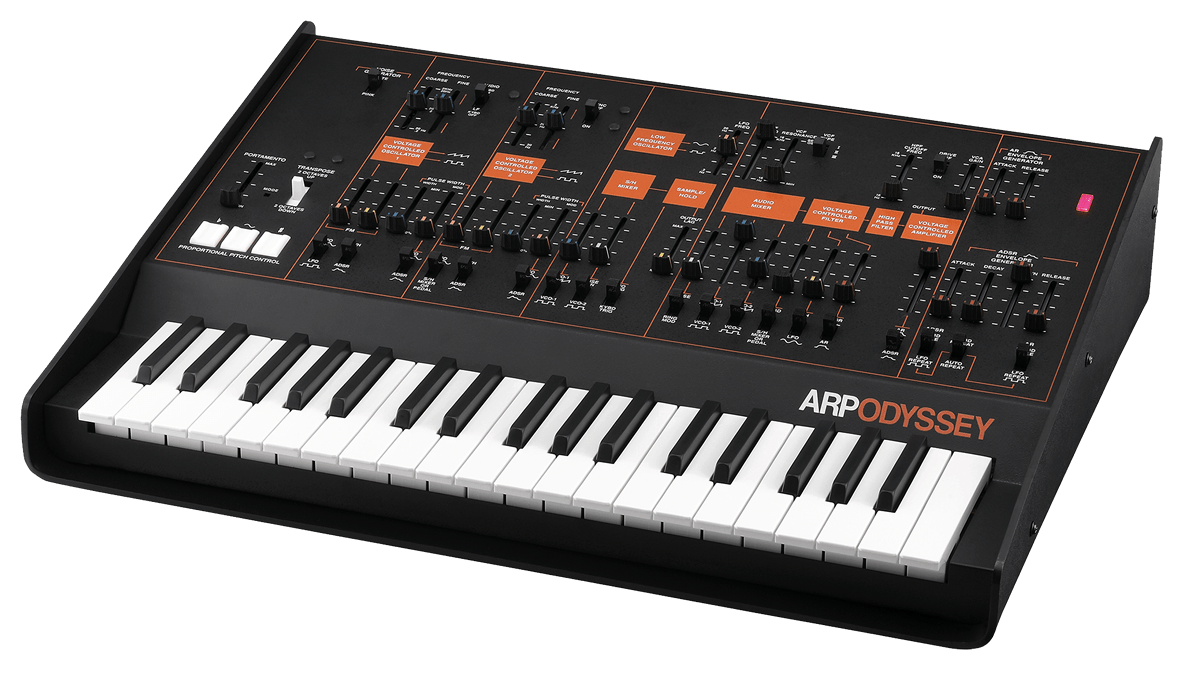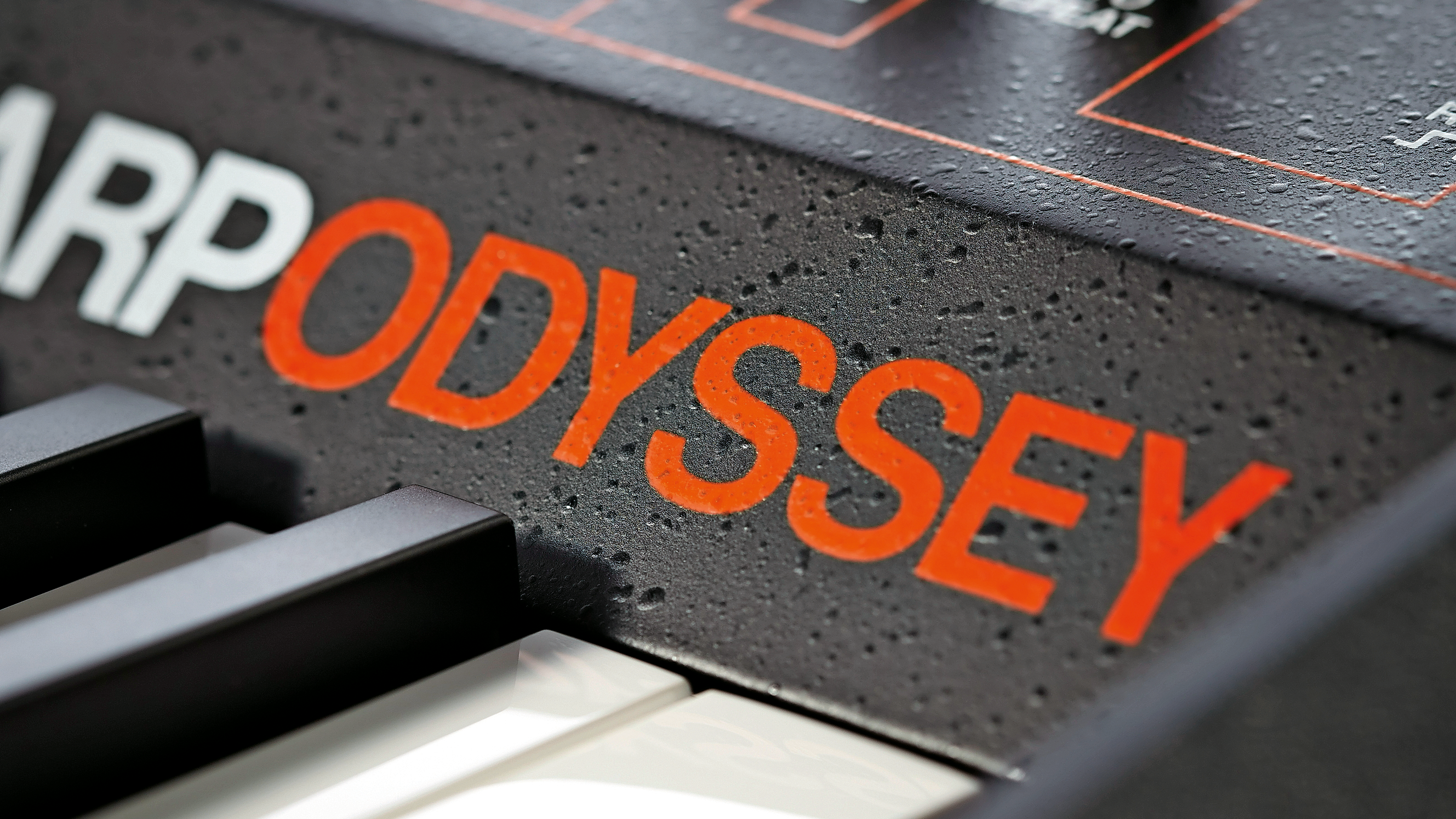Why does everyone love the ARP Odyssey?
It's the ARP Odyssey's 50th birthday, so now's a good time to ask - what's so great about it?

Today we revisit that 70s classic, the ARP Odyssey, in recognition of its 50th anniversary. This not only went toe to toe with the Minimoog in that decade, but featured in many a synth pop classic (thanks to just one man), and its forefathers even took on a bunch of aliens, twice… and won!
ARP were founded by Alan Robert Pearlman plus cofounders Lewis G. Pollock and David Friend in 1969. As the main force behind the company, Alan got to use his initials as the company name (so much better than LGP or DF would have panned out).
He also set out a clear direction for the company: to produce affordable – well, for the time anyway – stable and practical synthesisers, realising that the modular systems of the 60s were a million miles away from all three of these considerations.
The first thing to do was to invest in decent oscillator research, the fundamental core ingredient of synthesis, and the one variable that you could design to be not so variable and so stay in tune. The first fruits of this stability came in the form of the 1970 released ARP 2500, a hit with universities and research facilities (the main synth users of the time) and also with a certain alien species...
The company’s next synth, the ARP 2600 was era-, tech- and synth-defining. It was portable (OK, not that portable), had three oscillators, built-in speakers and its own spring reverb.
Much loved by everyone from Stevie Wonder to Underworld, it went through less than ten revisions over a ten-year period, and only sold around 3,000 units, but made such an impact that it is being emulated widely to this day by Korg and others in hardware, and many more in software. In fact it will get its very own feature like this one over coming months, but now to the start of the Odyssey’s, er, odyssey…
The Odyssey begins
As successful as Pearlman’s first forays into commercially available synthesisers were, Moog’s Minimoog, first released in 1970, was becoming a runaway success so, not surprisingly, Pearlman wanted in on the action, and the ARP Odyssey was born.
Want all the hottest music and gear news, reviews, deals, features and more, direct to your inbox? Sign up here.
The Odyssey was (and indeed is, as we shall see) a two-oscillator synth with both VCOs (saw or square and with sync) on the left, each featuring Coarse- and Fine-tuning sliders. As is standard these days, although not perhaps at the time, you then move into filter, mixer, amp and envelope sections, although the Odyssey features loads of extras to give its sound the edge.
The duophonic nature, noise, ring mod and sample and hold already give it a truly unique character but there’s more. The core oscillators have extras like FM and Pulse Width options and the FM sections of each can be modulated: VCO1 by sine or square waves, Sample & Hold or ADSR; OSC2 replaces the square wave with Pedal or S/M mixer modulation. The Pulse Width sections can each also be modulated by the LFO or ADSR.
Famous users are many and varied: everyone from ABBA to Elton John, Human League to Herbie Hancock, Ultravox to (of course) Jean-Michel Jarre
In addition to the two oscillators you also get a switchable pink or white noise generator. The next LFO section has a Frequency slider and two more sliders controlling the output from VCO1 (with two sources) and VCO2 (or noise) entering the S/H mixer.
In the mixer section you can simply adjust levels of the sources and how the filter reacts to the S/H mixer/pedal, LFO or envelope generators. Then there’s the most important section: the filters, with VCF Filter and Resonance controls for a low-pass option and a High Pass Frequency Cutoff Frequency slider. This was the most changeable section on the Odyssey as it developed, as we shall now attempt to explain (it’s not as easy as it should be).
Odyssey versions: 3 into 1
The Odyssey actually had three distinct versions, each luckily signified with easy to recognise colours, although there was a period between the different marked versions where the colours crossed over, so you can’t 100% rely on one colour meaning one version. But generally the MkI can be considered the white one, the MkII was black and gold, and the MkIII, orange and black.
The MkI Odyssey arrived in 1972 (model 2800) aimed at being a more compact version of the ARP 2600. The 4023 filter on this model was 2-pole voltage controlled. The MkII came out two years later, featuring that colour change (in the main) and with a new 4035 4-pole VCF filter (again, ‘in the main’ as some still feature the original filter!).
The ARP is still the king of tearing leads while the Moog will always deliver the best bass
After clashing with Moog over the original filter designs, ARP changed the 4035 filter to a 4075 during the MkII period, which was retained in the MkIII which arrived in 1978 (the 4035 MkII is still the most sought-after version). The synth remained in production until 1980 and, like its predecessor only sold around 3,000 units, but like the ARP 2600, it too certainly made its mark.
Famous users are many and varied with Stevie Wonder one of the first ARP fans, but followed by everyone from ABBA to Elton John, Human League to Herbie Hancock, Ultravox to (of course) Jean-Michel Jarre.

The Fender v Gibson of synths
And the synth achieved what Pearlman set out to do: rival the Minimoog. The success of both synth giants ignited a kind of 70s ‘Blur vs Oasis’ battle – or more aptly perhaps, Fender v Gibson – that still rages (on certain forums anyway) to this day.
Which was best monosynth of the 70s, the Minimoog or the ARP Odyssey? (And like the media tried to stir up a similar ‘who is the best, Westlife or Take That?’ debate, a similar rivalry sprung up in synth circles in the late 80s when the Roland D-50 and Yamaha DX7 took to the stage. And looking back, who really cared?)
You’d expect a glut of copycat software emulations, but there is a surprisingly small number available
The truth of course, of any comparison between these two monster monos is that both synths have their good and bad bits (well, good bits anyway) and, very generally speaking, the ARP is still the king of tearing leads while the Moog will always deliver the best bass.
If you are a fan of classic synths – and have deeper pockets than us – you’ll take one of each then. That’ll probably set you back a good five-figure sum, or you could opt for the remakes and software emulations.
New kids on the ARP block
With the success of the ARP Odyssey back in the 70s and 80s and its many appearances on so many iconic tracks, you’d expect a glut of copycat software emulations but there is a surprisingly small number available.
Retro Machines by Native Instruments touches on it, but not directly, and there were quite a few old attempts in the freeware world and Korg’s own software recreation (see Other ways to get the Odyssey sound box). But the first – and many would say best – software emulation came by way of GForce Software, and their Oddity, now at version 2, is our Odyssey desktop software contender.
Released in 2002 – yes, soft synths were around then – the original Mk1 GForce Oddity perfectly captured the character of the original ARP. Oddity 2 arrived a full 12 years later – it’s fair to say that GForce like to take their time to get things right. But get it right they do. Oddity 2 added polyphony and bolstered the mono mode with legato triggering modes, while Oddity 3 brought a powerful new Preset Browser along with distortion and reverb effects.
It also beefed up the modulation options with an X-LFO and X-ADSR section, added a sub oscillator for extra bass clout and included several other nice touches along with a mountain of fabulous presets.

It is indeed an amazing emulation of the Odyssey with all the modern bells and whistles added (although you can even keep it real in duo- and monophonic modes). Importantly it also boasts all three of the filters found in the three Odyssey versions and it’s fair to say we liked it: “GForce have surpassed our expectations with the second coming of their flagship synth,” we said in our original review.
“Oddity was almost perfect before, but this is an upgrade that simply can’t be missed.” We concluded: “A spot-on emulation of the classic ARP Odyssey in its various incarnations, with some very well thought-out new features.” And then heaped a 10/10 score on it.
The final Odyssei
Another fantastic Odyssey emulation comes by way of the iOS Korg/ARP Odyssei. This came out in late 2016 and, again, scored very well all around. You could see it as an iOS version of Korg’s hardware recreation of ARP’s original, but let’s just see it as a great ARP emulation, again with some extras.
You can switch between those three filter types again and unlike the duophonic hardware, Odyssei has monophonic, duophonic and polyphonic modes. There’s also a 16-step arpeggiator, six effects and X/Y pads for real-time manual manipulation.
But it all comes down to the sound and on this we said in our review, “Odyssei sounds tremendous, doing a stellar job of recreating those famously edgy oscillators and that razor sharp low-pass filter serving as a powerful source of basses, leads, pads and sci-fi style FX.”


Computer Music magazine is the world’s best selling publication dedicated solely to making great music with your Mac or PC computer. Each issue it brings its lucky readers the best in cutting-edge tutorials, need-to-know, expert software reviews and even all the tools you actually need to make great music today, courtesy of our legendary CM Plugin Suite.
